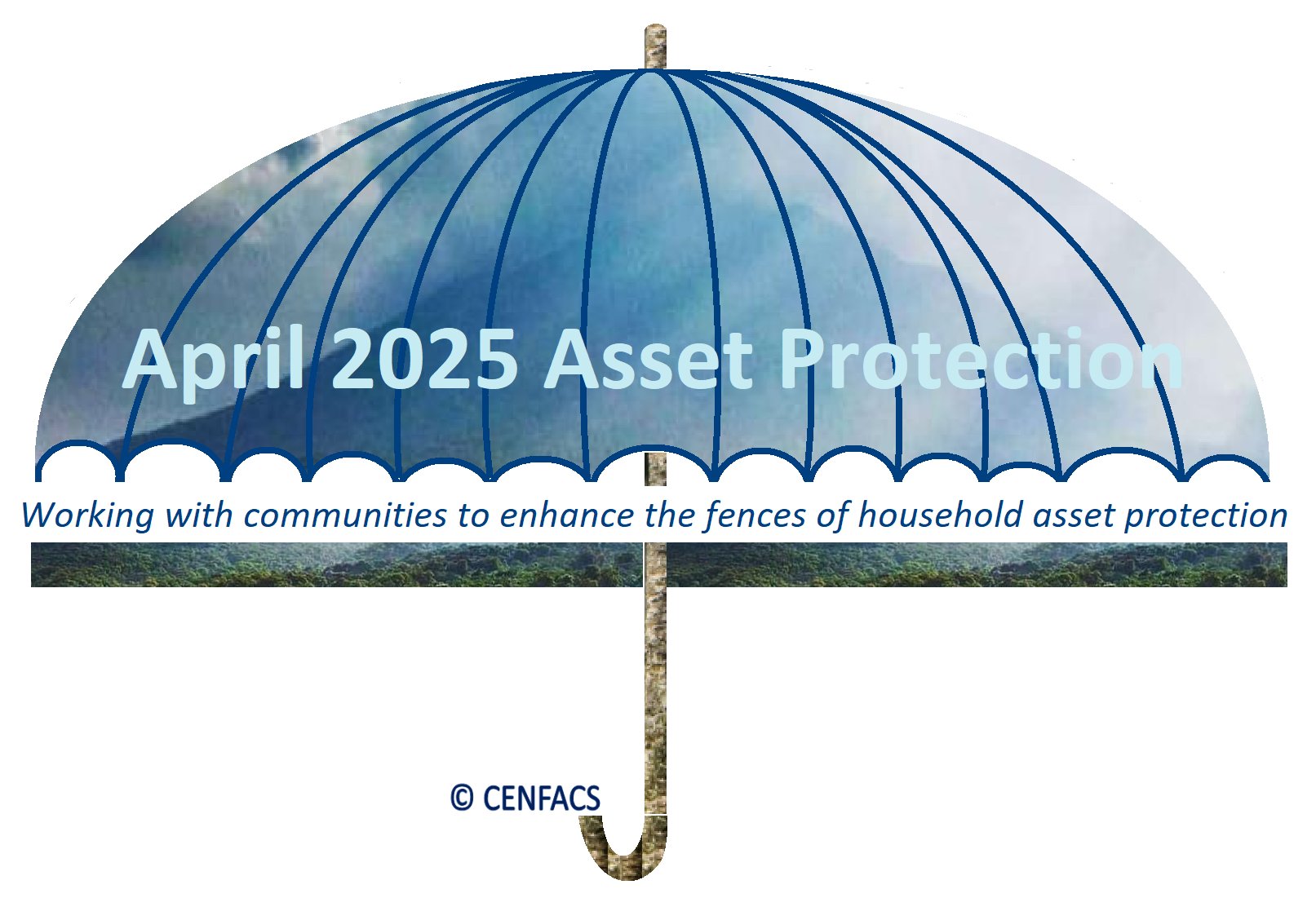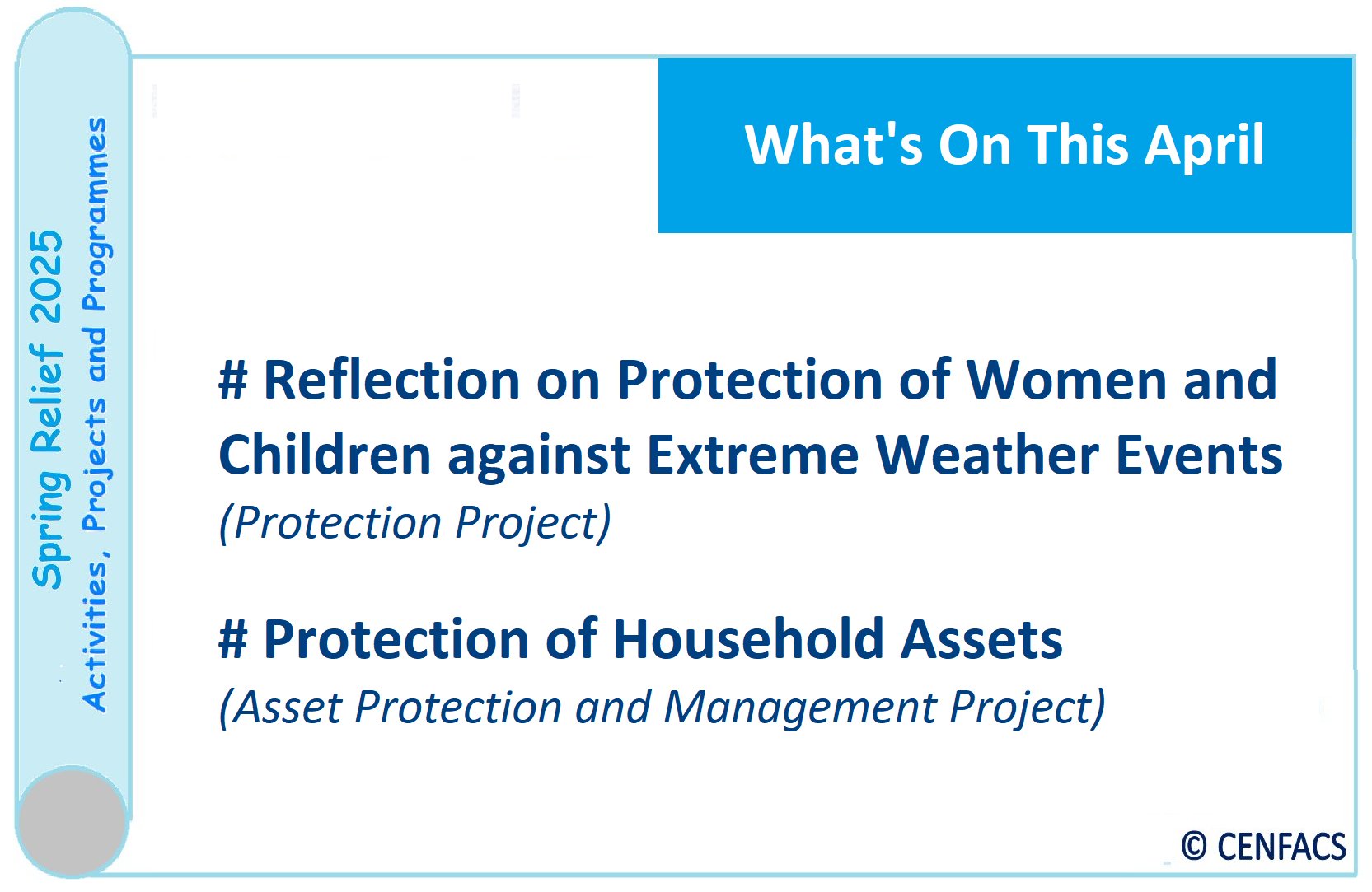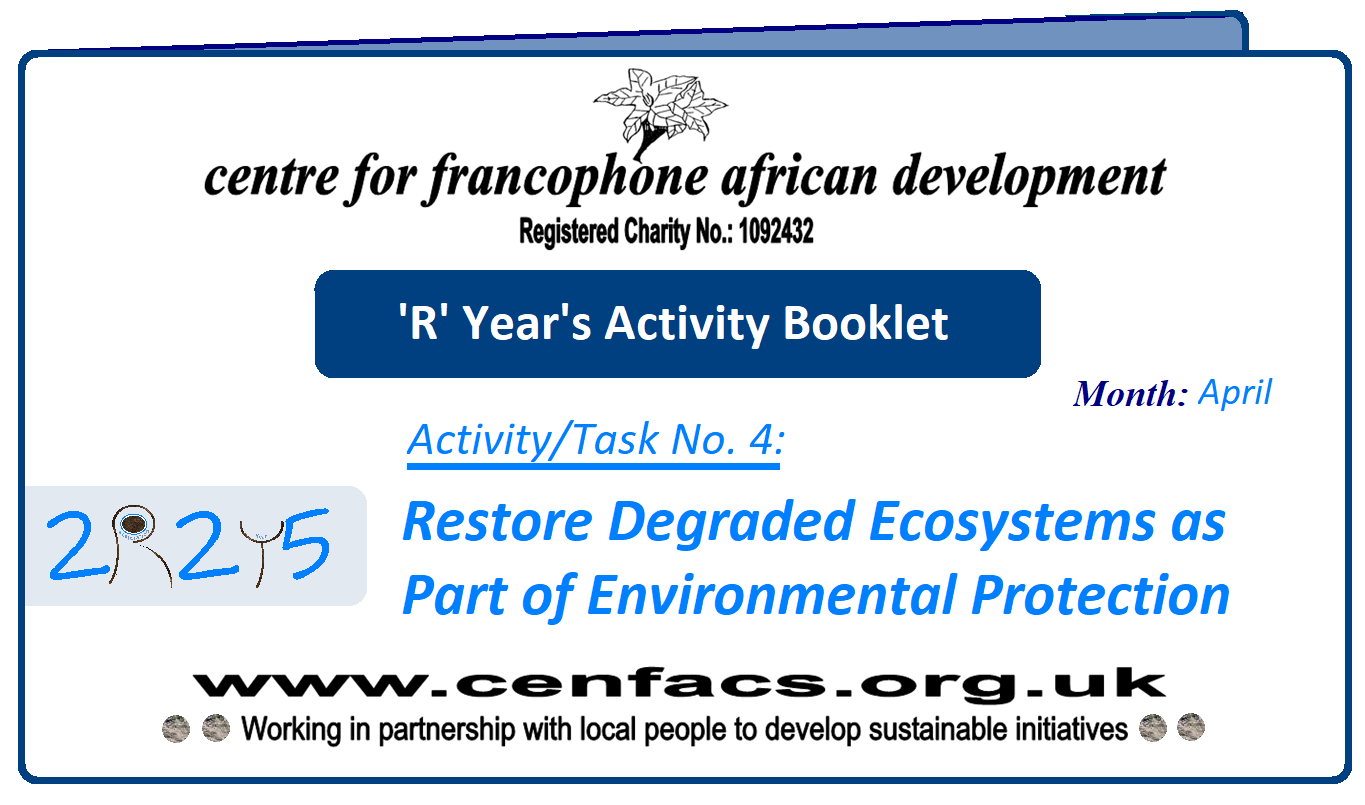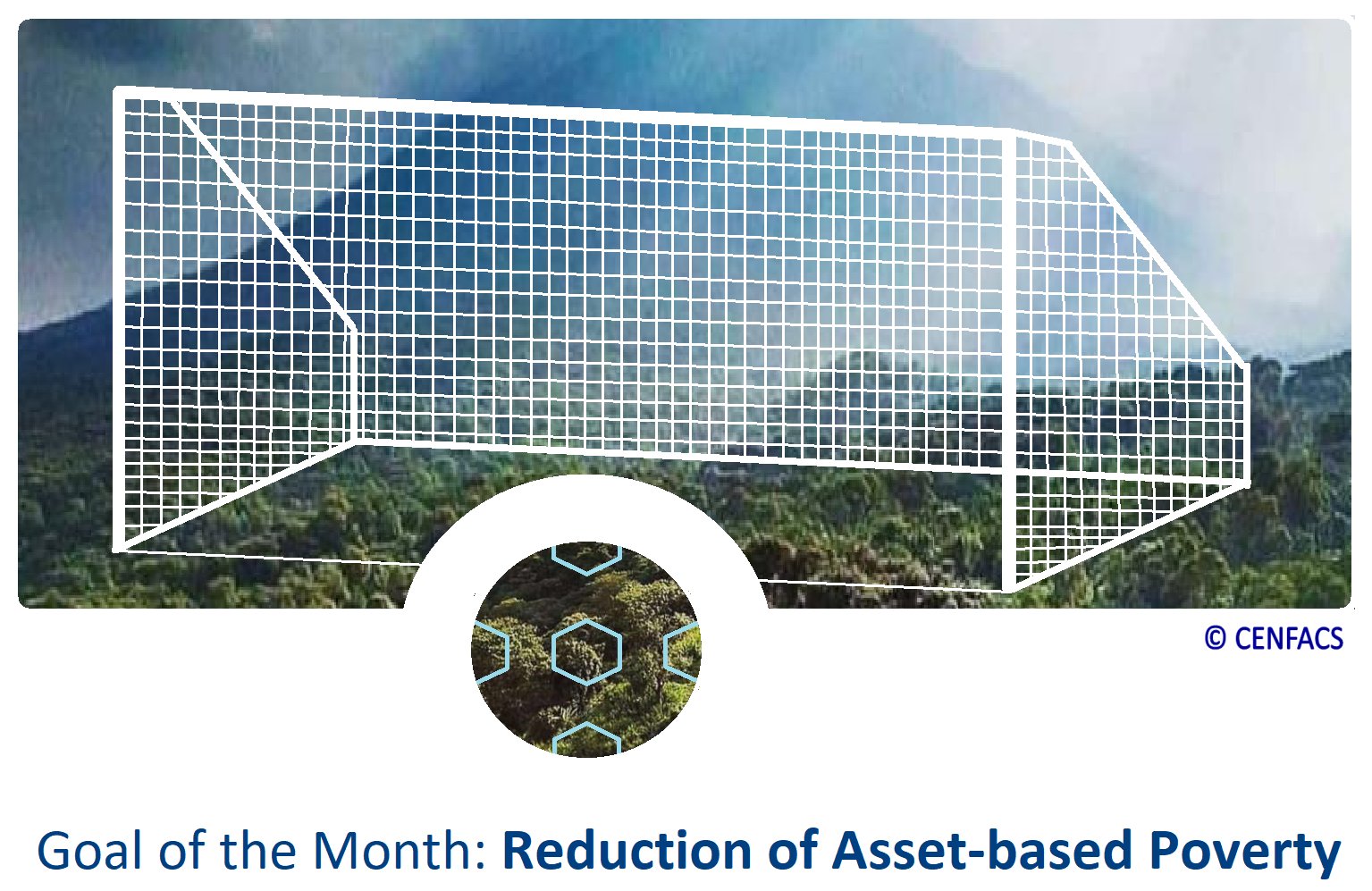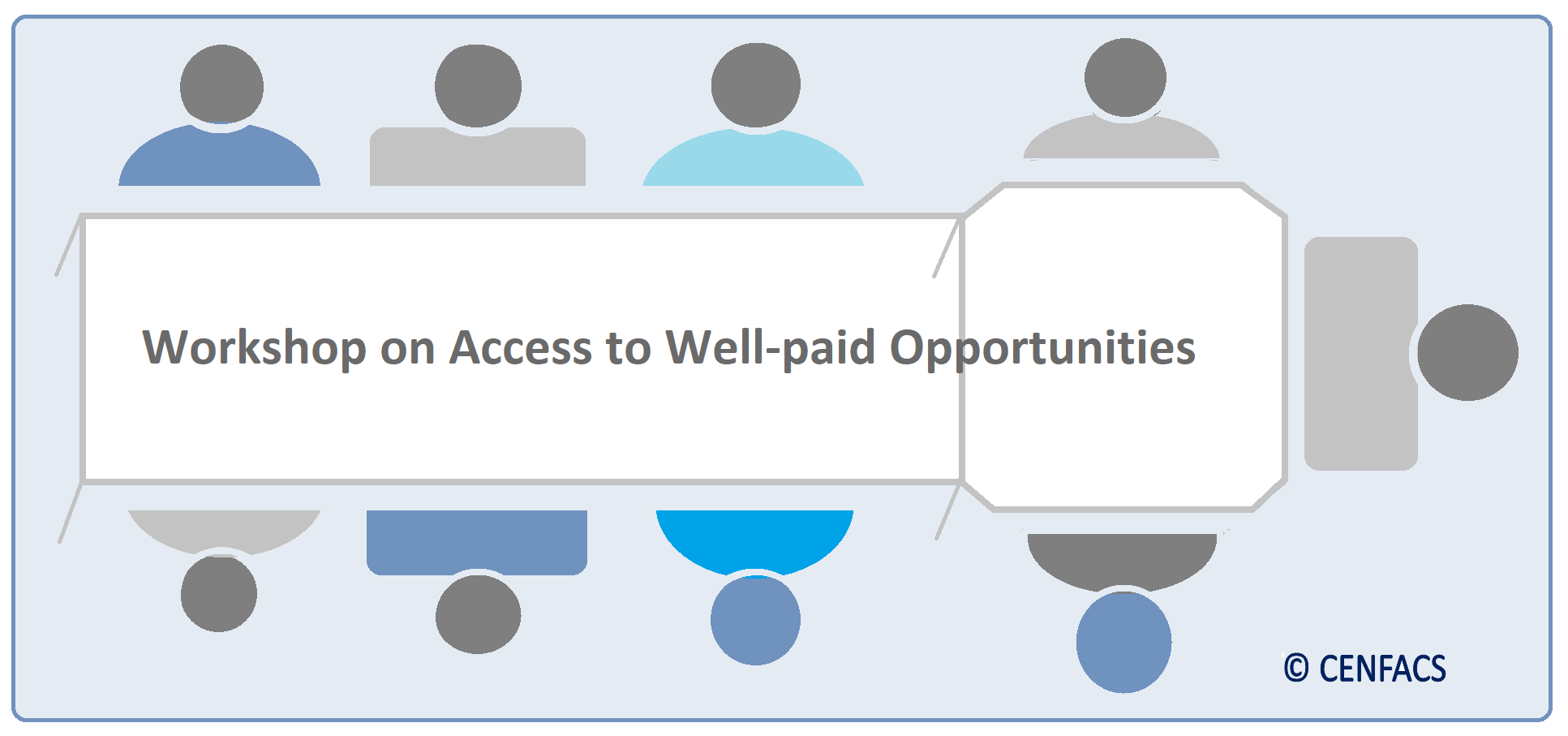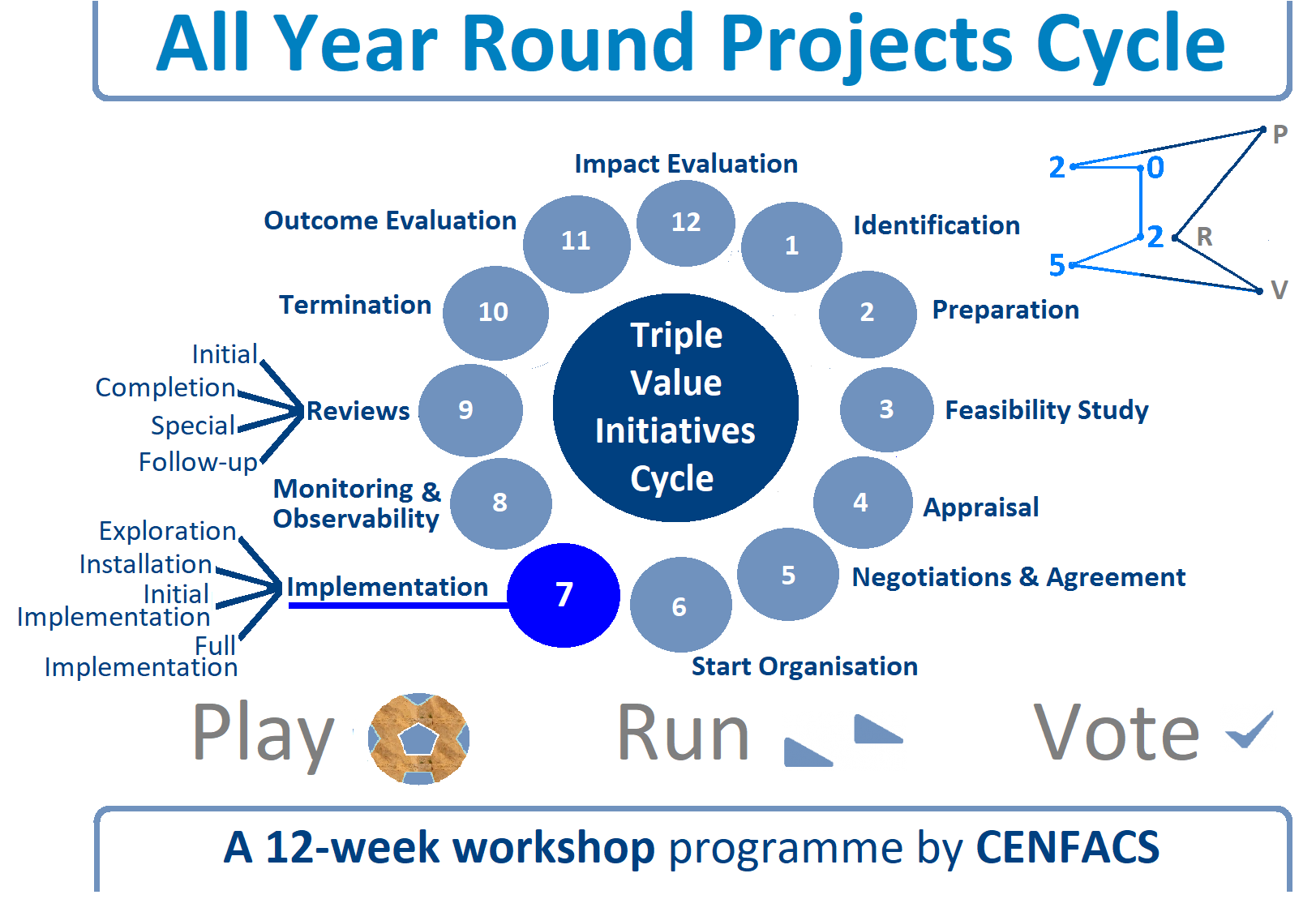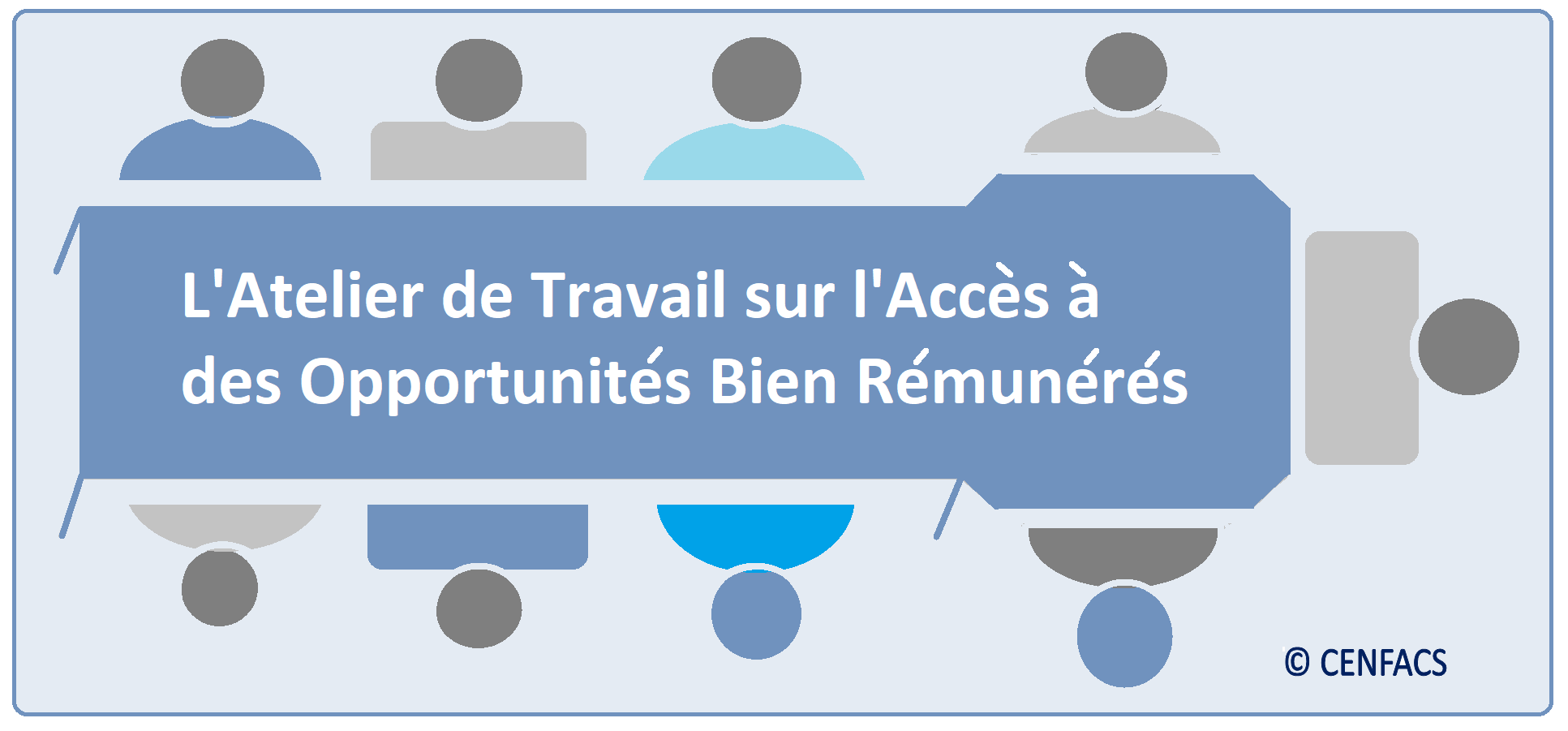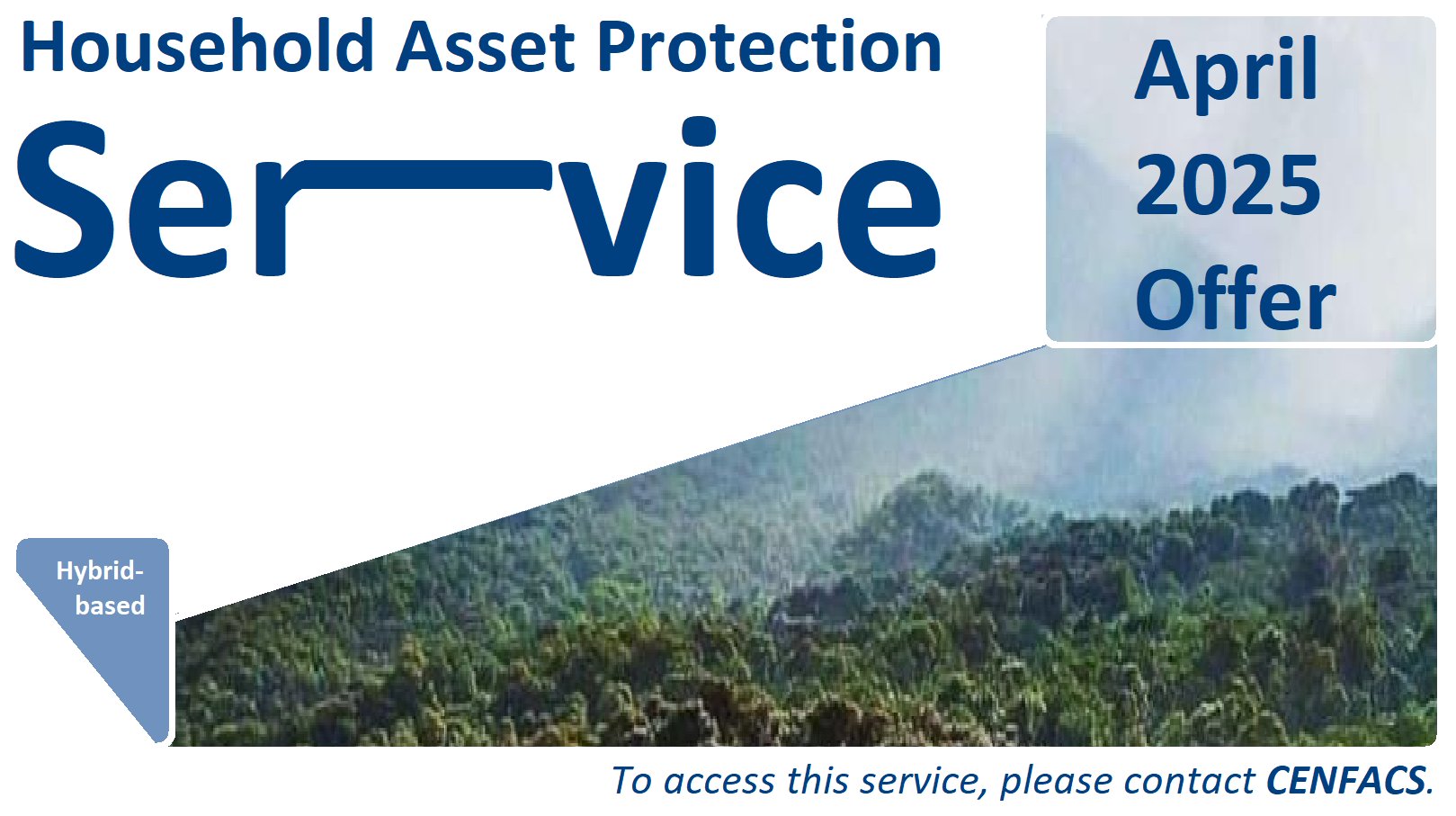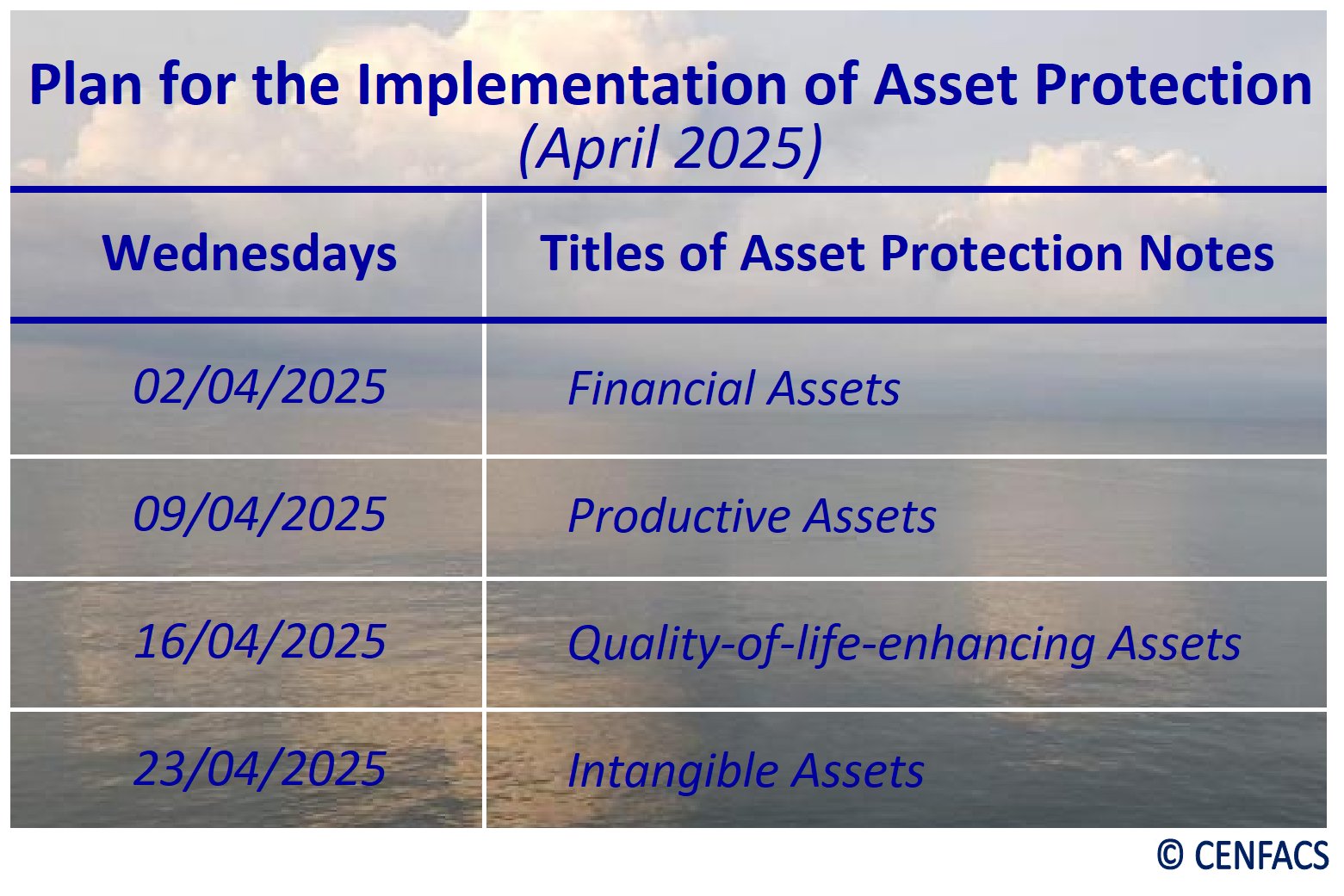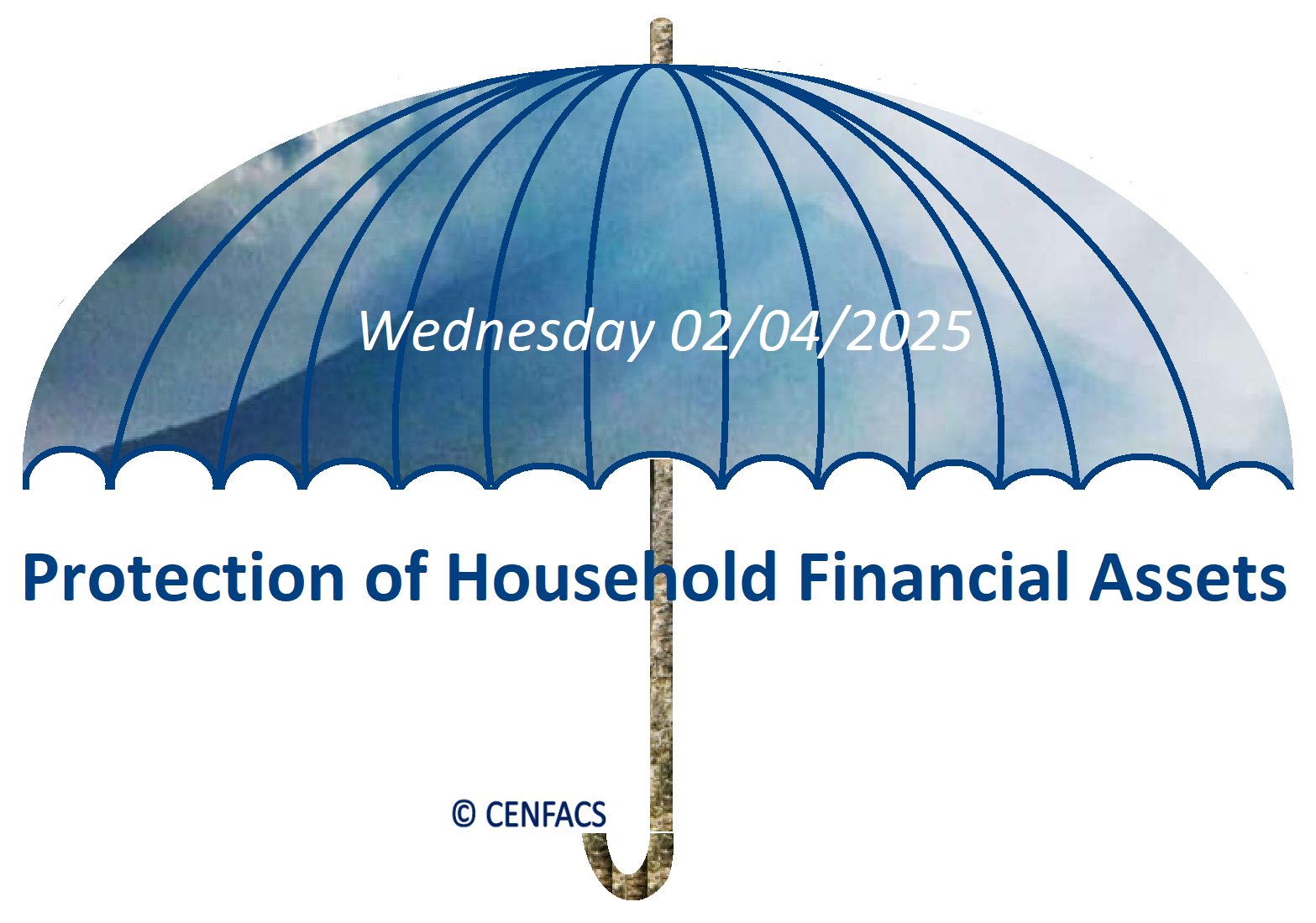Welcome to CENFACS’ Online Diary!
02 April 2025
Post No. 398
The Week’s Contents
• Protection Month with the Protection of Poor Households’ Assets
• ReLive Issue No. 17, Spring 2025: The Returned Internally Displaced Persons in Africa Need Some Assistance to Rebuild and Renew Their Lives, Can You Help?
• Activity/Task 4 of the ‘R’ Project: Restore Degraded Ecosystems as Part of Environmental Protection
… And much more!
Key Messages
• Protection Month with the Protection of Poor Households’ Assets
It is known that poor people and households often lack financial resources and wealth. But, they can still possess valuable assets such as physical possessions, skills, and social connections. These valuable assets are crucial for reducing poverty and vulnerability while improving the quality of their life or livelihoods.
Their valuable assets need protection which can help keep them safe. In this respect, protecting poor household assets would involve safeguarding their possessions and other assets they possess from potential risks which could be lawsuits, creditors or unexpected costs or crises. Asset protection for poor households can be achieved using a number of strategies such as social protection programmes, asset-building initiatives, legal and regulatory frameworks, financial inclusion, education and awareness.
During this Month of Protection, we shall work with poor households in finding out the best way of protecting their assets (like real estate, financial assets, personal property and business assets). In our work with them, we shall as well refer to the accessible and affordable asset protection strategies for them, while helping them to work out the value of their net worth or wealth (that is, the total of their assets minus the total of their liabilities or debts). We shall also explore ways of reducing asset-based poverty, that is the lack of sufficient wealth or assets to meet their basic needs for a period of time.
This Month of Protection is finally of dealing with other areas of protection such as the protection of flora, fauna, funga and beneficial micro-organisms. This is without forgetting protection against the adverse impacts of climate through our Climate Follow-up Talks Project known as Taking Climate Protection and Stake for African Children.
All the above-mentioned areas of work for this month are summarised in CENFACS’ Action Plan for April 2025. To find more about this action plan and what is likely to be the Month of Protection within CENFACS, please read under the Main Development section of this post.
• ReLive Issue No. 17, Spring 2025: The Returned Internally Displaced Persons in Africa Need Some Assistance to Rebuild and Renew Their Lives, Can You Help?
• • What is ReLive?
ReLive is one of CENFACS’ Spring campaigns and a bridge between CENFACS’ Winter Lights and Spring Relief seasons.
ReLive advocacy is designed to plead for help to the peoples and communities whose lives and livelihoods have been destroyed to rebuild themselves. The current appeal will try to achieve this for the returnees from forced internal displacements in Africa this Spring 2025.
Although this appeal is a seasonal appeal related to Spring, it is also a consolidated one following our Winter Light appeals.
• • What Is the Focus for ReLive in 2025?
The 17th issue of CENFACS’ Once-a-year Spring Appeal for Renewing Lives (ReLive) will focus on advocating for the support of returned and returning internal displaced persons in Africa and for policies that help their return and integration. This can be done by securing relevant funding to support these returnees and a process of reintegration aiming at helping them to rebuild and renew their lives and communities.
• • What Is ReLive in 2025 about?
It is about working with Africans internally displaced from their homes by conflicts, violence, human rights violation and natural disasters or climate change events, and who have been returned or are returning, since the conditions for safe and sustainable return and reintegration are in place.
According to the statistics of February 2025 from the United Nations Refugee Agency (1), there have been 8.1 million internally displaced persons and 1.7 million returned internally displaced in Africa.
The returned and returning internally displaced persons need support of all kinds as they face enormous challenges.
• • Challenges for Returnees
Returnees from internal displacements often face challenges in reintegrating into their communities, including difficulties in accessing land, housing, food, health and social services, and livelihoods. They may even face re-displacement if there is any eruption of new conflicts or natural disasters or inability to reintegrate. They need help and support. There are African governments that have policies to protect and assist returned and retuning internally displaced persons. However, with the current cuts to aid budgets by some developed countries, many of these returnees are left without support.
• • What ReLive Campaign Will Bring to the Returnees
The Campaign will help
≈ give to the returnees a fresh start
≈ rebuild or repair infrastructures (like schools, water systems, roads and healthcare)
≈ them reintegrate and access rights
≈ them find housing and work
≈ them enrol children in schools
≈ them get cash assistance to cover initial basic needs such as personal hygiene items and rent, rehabilitate land
≈ in brief rebuild and renew lives in a gradual, safe and sustainable way.
Like before, the Campaign is done through Gifts of Renewing Lives or Life-renewing Projects.
• • What Are Gifts of Renewing Lives or Life-renewing Projects (LRPS)?
Life-renewing projects (LRPs) are poverty relief and Spring like gifts designed to materialise ReLive advocacy by helping people to set free from multi-dimensional deprivations and hardships so that they can start up again, renew and rebuild their lives with hope.
LRPs are part of CENFACS’ African Rebuilding and Sustaining Infrastructures and Lives Programme. Spring Gifts of Renewing Lives are about bringing renewal, joy and hope to needy people. These Spring 2025 Gifts will be about bringing the same benefits to the Returnees from Forcibly Internal Displacements in Africa.
• • What Are These Ways or Gifts of Renewing Lives?
This Spring, we are running 14 Gifts in a world of 20 Reliefs or Helpful Differences. What does this mean?
It means donors or funders have 14 Gifts of Renewing Lives to choose from and 20 Reliefs to select from to make helpful differences to the returnees.
In total, our Spring Relief 2025 Campaign is providing to potential supporters 14 GIFTS of rebuilding returnees’ lives in Africa in 20 RELIEFS to make this happen.
For this renewal to happen, support is needed towards LRPs.
To support, go to http://cenfacs.org.uk/supporting-us/
• Activity/Task 4 of the ‘R’ Project: Restore Degraded Ecosystems as Part of Environmental Protection
The fourth activity/task of the “R” Project is about Restoring Degraded Ecosystems as Part of Environmental Protection. Indeed, protecting ecosystems can include the work of restoration of degraded ecosystems. It involves actions like reforestation and afforestation, habitat restoration and sustainable management; while improving biodiversity, ecosystem services and supporting human well-being. This is because restoration can seek to return cleared land or degraded ecosystems to a condition or function comparable to that which would have been there prior to disturbance.
When restoration tends to do that, one may speak about ecosystems protection, which is simply the defence of ecosystems (that is the organisms like plants, animals, fungi and beneficial micro-organisms living in a particular habitat, along with their immediate physical environment) against any harm and danger.
So, this month of April, Activity/Task 4 is about Restoring Degraded Ecosystems as Part of Environmental Protection.
For those who need any help before embarking on this activity/task, they can speak to CENFACS.
For any other queries and enquiries about the ‘R‘ project and this year’s dedication, please contact CENFACS as well.
Extra Messages
• Goal of the Month: Reduction of Asset-based Poverty
• Activity 2 of the Economic Inclusion Programme for Households’ Opportunity: Workshop on Access to Well Paid Opportunities (From 09/04/2025)
• All-year Round Projects Cycle (Triple Value Initiatives Cycle) – Step/Workshop 7: Implementing Your Play, Run and Vote Projects
• Goal of the Month: Reduction of Asset-based Poverty
Accumulating assets is a step forward to improving people’s livelihoods and to helping them transition out of poverty. Conversely, losing assets can make people to transition into poverty or simply preventing them from escaping it.
Not able to accumulate assets can lead to asset-based poverty, which is simply the lack of sufficient wealth or assets to meet basic needs for a period of time. It is this type of poverty we are trying to help reduce or address this month.
• • Addressing Asset-based Poverty
Knowing what asset-based poverty is, we shall try to address the barriers to accumulating assets as well as the causes of asset loss (like distress sales, health shocks, lack of savings, low income, high costs, inefficiency or inadequacy, etc.).
For instance, we can work with those who may be interested in this topic ways of improving asset accumulation for those in need so that they can increase their ability to access more opportunities in their life. Also, we shall look at the implications for selecting asset-based poverty reduction as our goal for April 2025.
• • Implications for Selecting the Goal for the Month
After selecting the goal for the month, we focus our efforts and mind set on the selected goal by making sure that in our real life we apply it. We also expect our supporters to go for the goal of the month by working on the same goal and by supporting those who may be suffering from the type of poverty linked to the goal for the month we are talking about during the given month (e.g., April 2025).
For further details on the goal of the month, its selection procedure including its support and how one can go for it, please contact CENFACS.
• Activity 2 of the Economic Inclusion Programme for Households’ Opportunity: Workshop on Access to Well Paid Opportunities (From 09/04/2025)
Activity 2, which will be run in the form of workshop, will provide some guidance and information about ways of accessing well-paid or decent remunerative opportunities. Perhaps, the easiest way of preparing for this workshop is to explain what is access and what is opportunity; then to provide the matters that the workshop will cover.
• • Understanding Access and Opportunity
Explaining the difference between access and opportunity, the website ‘thisvsthat.io’ (2) argues that
“Access refers to the availability and ability to reach resources, services, and opportunities. It encompasses factors such as physical proximity, affordability, and inclusivity. On the other hand, opportunity refers to the chance and possibilities that are presented to individuals to improve their circumstances and achieve their goals, while access focuses on the availability of resources, opportunity emphasizes the potential for growth and advancement”.
So, accessing well-paid opportunities refers to the availability and ability to grab these chances and possibilities that are presented to households so that they can improve their conditions and achieve their goals. During the workshop, we are going to explore what we have just described.
• • Matters To Be Covered by the Workshop
The workshop will draw on the areas covered by the previous UK Government Response to the In-work Progression Commission’s Report (3). In particular, we shall deal with the following three matters:
≈ Making work pay and boosting work incentives of low-income households
≈ Giving people greater opportunities to develop new skills or enhance and utilise existing skills
≈ Extra help or support for households in tackling barriers to better paid work and taking up opportunities for higher skills, higher paying jobs.
Those who may be interested in the workshop can let CENFACS know.
Those members of the CENFACS Community who would like to get involved in the workshop can contact CENFACS.
For any other queries and or enquiries about this workshop or Economic Inclusion Programme for Households’ Opportunity, please communicate with CENFACS.
• All-year Round Projects Cycle (Triple Value Initiatives Cycle) –
Step/Workshop 7: Implementing Your Play, Run and Vote Projects
After making the organisational structure of your chosen Play, Run and Vote Projects, it is now the time to proceed with the Implementation Step.
• • What Is an Implementation Step?
There are many definitions within the literature about project implementation. One of them comes from ‘taskmanagementguide.com’ (4) which states that
“Project implementation is a practice of executing or carrying out a project under a certain plan in order to complete this project and produce desired results”.
The above definition indicates that one needs an implementation plan. As an all-year-round project implementor, you can draw up your implementation plan that shows the way you would like to execute and carry out your project.
Having said that Project Implementation is the step you put your project plan into action. This step can be broken into exploration, installation, initial implementation and full implementation. Because all-year round projects are such small initiatives, you will not need to break this step.
You want your all-year-round project to fulfil and accomplish the goals and objectives you have set up for it. It is also the phase during which you can register, review and approve/reject any changes and variations. As an all-year-round project manager of your project, you need to coordinate all project aspects and resources to meet the objectives of the project plan. One of the aspects of the project implementation is change control.
• • What Is Change Control in a Project implementation Process?
The website ‘ecampusontario.pressbooks.pub’ (5) states that
“Change control is a set of procedures that lets you make changes in an organised way”.
The same ‘ecampusontario.pressbooks.pub’ explains this:
“If you find a problem,… you will need to look at how it affects the triple constraint (time, cost, scope) and how it impacts the project quality… If you evaluate the impact of the change and find it won’t have an impact on the project triple constraint, then you can make the change without going through change control”.
• • An Example of Implementing Your All-year Round Projects
Let us take the example of Voting Your 2025 International Development and Poverty Reduction Manager.
Your goal is to find a person who will meet the managerial qualities of such a position. Amongst the objectives are the design of a job description and person specification that match with the profile of your ideal International Development and Poverty Reduction Manager of the Year.
In project implementation jargon, you will put approved plan into practice to proceed with the selection of your International Development and Poverty Reduction Manager of the Year. He/she must meet your selection criteria. If you are voting as a group, you could set up a selection panel or recruitment board like you will do it for real job interview. You can start by shortlisting 12 candidates, cutting down your list to 6, then to 3 until you reach/vote the last one, who has scored the best and most results of your jury questions and responded to most criteria.
You can decide to add a fundraising feature to your voting activity.
• • Fundraising during the Vote of International Development and Poverty Reduction Manager of the Year
You can invite the members of the public pay to participate in voting and/or to participate in the selection procedure. Their payment will be the money you will raise for good causes like CENFACS‘ noble and beautiful ones. The money raised will help to make a difference in the lives of those we serve.
For those who would like to dive deeper into Implementing their Play or Run or Vote project, they should not hesitate to contact CENFACS.
Message in French (Message en français)
• Activité 2 du Programme d’Inclusion Economique pour les Ménages : Atelier sur l’Accès à des Opportunités Bien Rémunérées (à partir du 09/04/2025)
L’activité 2, qui se déroulera sous la forme d’un atelier, fournira des conseils et des informations sur les moyens d’accéder à des opportunités bien rémunérées. Peut-être que la façon la plus simple de se préparer à cet atelier est de savoir ce qu’est l’accès et ce qu’est l’opportunité ; puis de fournir les sujets que l’atelier abordera.
• • Comprendre l’accès et les opportunités
Expliquant la différence entre l’accès et l’opportunité, le site web « thisvsthat.io » (2) dit que
« L’accès fait référence à la disponibilité et à la capacité d’accéder aux ressources, aux services et aux opportunités. Il englobe des facteurs tels que la proximité physique, l’abordabilité et l’inclusion. D’autre part, l’opportunité fait référence à la chance et aux possibilités qui sont présentées aux individus pour améliorer leur situation et atteindre leurs objectifs, tandis que l’accès se concentre sur la disponibilité des ressources, l’opportunité met l’accent sur le potentiel de croissance et d’avancement ».
Ainsi, l’accès à des opportunités bien rémunérées fait référence à la disponibilité et à la capacité de saisir ces opportunités et possibilités qui sont présentées aux ménages afin qu’ils puissent améliorer leurs conditions et atteindre leurs objectifs. Au cours de l’atelier, nous allons explorer ce que nous venons de décrire.• • Points à couvrir par l’atelier
L’atelier s’appuiera sur les domaines couverts par la précédente réponse du Gouvernement Britannique au rapport de la Commission de Progression de l’Emploi (3). En particulier, nous traiterons des trois questions suivantes :
≈ Rendre le travail rémunérateur et renforcer les incitations au travail pour les ménages à faible revenu
≈ Donner aux gens plus de possibilités de développer de nouvelles compétences ou d’améliorer et d’utiliser les compétences existantes
≈ Aide ou soutien supplémentaire aux ménages pour les aider à surmonter les obstacles à un travail mieux rémunéré et à saisir les opportunités d’emplois plus qualifiés et mieux rémunérés.Ceux/celles qui pourraient être intéressé(e)s par l’atelier peuvent le faire savoir au CENFACS.
Les membres de la communauté CENFACS qui souhaitent s’impliquer dans l’atelier peuvent contacter le CENFACS.
Pour toute autre question et/ou demande de renseignements sur cet atelier ou le Programme d’Inclusion Économique pour les Ménages, veuillez communiquer avec le CENFACS.
Main Development
• Protection Month with the Protection of Poor Households’ Assets
Protecting the assets of poor households involves strategies and policies that safeguard their livelihoods and financial stability. The following contents will help to approach these strategies and policies, as well as the other elements constituent of asset protection for poor households:
≈ What Is Asset Protection?
≈ Strategies for Protecting Poor Households’ Assets
≈ Types of Poor Households’ Assets to Protect
≈ Action Plan for the Implementation of Asset Protection This April 2025
≈ From Wednesday 02/04/2025: Financial Asset Protection for Poor Households
≈ Other Areas of Protection.
Let us look at each of these contents.
• • What Is Asset Protection?
There are many ways of defining asset protection. In the context of these notes, the definition used here comes from ‘ocelderlaw.com’ (6), which explains that
“Asset protection is a set of strategies designed to safeguard your wealth from various risks, such as creditor claims, lawsuits, and other financial threats. It involves legally insulating assets to prevent their seizure or loss while staying within the bounds of the law”.
The website ‘ocelderlaw.com’ also provides the necessary steps for effective asset protection, steps, which are: identification of assets, asset risks assessment, choice of asset protection strategies, implementation of asset protection strategies, regular review and adjustments of your asset protection strategies.
There are several methods to protect your assets, which have been highlighted under the following content.
• • Strategies for Protecting Poor Households’ Assets
Within the literature about asset protection, it is published a number of strategies to protect assets of poor households. Among the strategies found, we can mention those below.
• • • Social protection programmes (SPPs)
SPPs can provide social insurance which can help prevent asset loss and improve livelihoods.
• • • Asset-building initiatives (AbIs)
AbIs focus on helping poor households accumulate assets through savings, credit and investment in productive assets.
• • • Legal and regulatory frameworks (L&RFs)
L&RFs can protect property rights, prevent land grabbing, and ensure access to credit and financial services for poor households.
• • • Financial inclusion programmes (FIPs)
Generally, FIPs will provide access to financial services, such as savings accounts, credit and insurance, and can help poor households manage their finances and protect their assets.
• • • Educational and awareness programmes (E&APs)
E&APs help educating poor households about financial literacy and numeracy, asset management, and their rights.
• • • Asset transfer programmes (ATPs)
ATPs provide a one-off large scale asset transfer (like livestock) combined with complementary training.
• • • Asset protection trusts
There are trusts that safeguard assets from unexpected costs or changes.
The above-mentioned strategies indicate that there are various ways of shielding your assets. But, what are those assets that poor households would like to protect?
• • Types of Poor Households’ Assets to Protect
It is known that poor people and households often lack financial resources and wealth. But, they can still possess valuable assets such as physical possessions, skills, and social connections.
The Types of their assets that need protection include the following ones:
≈ Financial assets (they include cash, bank deposits, stocks, bonds, and investments)
≈ Productive assets (e.g., land, livestock, farm equipment, business assets, etc.)
≈ Quality-of-life-enhancing assets (such as housing, basic utilities, home appliances, vehicles, etc.)
≈ Intangible assets (like social capital, human capital, political capital, cultural capital, access to credit, etc.).
These assets need protection and are important for livelihood, well-being and asset-poverty reduction of poor households. These types of assets make up the different areas of protection that we would like to cover this April 2025 and which frame our asset protection action plan.
• • Action Plan for the Implementation of Asset Protection This April 2025
To implement asset protection this April 2025, we have selected four key notes, which are given in the table below.
These notes will be developed starting every Wednesdays of April 2025 as scheduled above.
Also, this plan of protection needs to be combined with the Spring Relief 2025 Activities, Projects and Programmes (which we released on the 26 March 2025 in our Post No. 397).
Besides these selected notes and areas of protection, we would like to keep on working on other areas that need particular attention, like protection of flora, fauna, funga and beneficial micro-organisms; and climate protection.
Before summarising these other areas of protection, let us look at the first selected key note of our plan, which is Financial Asset Protection for Poor Households.
• • From Wednesday 02/04/2025: Financial Asset Protection for Poor Households
It is known that poor households have limited or no financial assets. Their wealth consists of basic necessities and sometimes with modest savings or investments. The limited financial assets they have need protection.
• • • Limited financial assets of poor households that need protection
They include the following ones:
≈ Their limited wealth expressed as the minimum they need for survival
≈ Limited resources to meet basic needs
≈ Debts or their financial liabilities that exceed their assets
≈ Their access to financial products
≈ Small savings
etc.
Besides the above-mentioned financial assets, protection is also needed for their tangible assets (like properties, vehicles, household goods, etc.) which can be a source of financial wealth.
• • • Ways in which CENFACS can work with the Community regarding Financial Asset Protection
How to engage the community, particularly households or families making our community, in terms of protection of their financial assets
CENFACS can work with households making its community to tackle issues relating to the loss of asset value by implementing with those households that would like to develop an asset management plan. To be more specific, CENFACS can engage the community on the matter of financial asset protection in a number of the ways like the following:
√ Financial strategy to choose to accumulate financial assets
√ Affordable financial asset protection programmes to select from
√ Financial assets they need to stay resilient to shocks and crises
√ How to use their asset ownership to have a greater control over their lives and opportunities
√ How to break the cycle of poverty through financial asset protection
√ Working out their net worth or wealth
√ Looking at their financial assets and evaluating them
√ Carrying out financial asset management and analytics with them
√ Setting up a basic asset protection plan
√ Getting informed about financial asset opportunities
√ Providing them with leads to financial asset protection for the poor
√ Guiding them on the best possible options to asset protection
√ Explaining them financial asset protection products and tools for poor households
√ Adding an inflationary index-link to their financial asset protection plan
√ Helping them to read and understand financial asset protection literature and information
√ Advising them on how to react and prepare for financial news, warnings, notices and alert messages about financial asset protection
√ Developing the basic financial skills to interpret the impact of economic indicators (like inflation, interest rate, exchange rate, etc.) on financial asset protection
√ Building their financial literacy statistics and numeracy skills to enable them to read financial information pages about financial asset protection (e.g. charts, tables, in brief infographics about financial asset protection)
√ Organising activities or workshops to help them embrace financial asset protection in the handling of their household financial affairs and plans
√ Improving their knowledge in terms of the key financial asset protection dates to save in the calendar about key policy announcements
√ Motivating them to follow news and information about financial asset protection
√ Asking them to subscribe to free providers of financial asset protection information that touches their life (e.g. free subscription to magazines, papers and websites that provide information about financial asset protection for poor households)
etc.
All these ways of working with the community will help to protect them and their financial assets. This is because the more informed they are, the more they will find the tools, tips and hints they need in order to protect their financial assets. It is all about working with them to develop and improve the strategies and practices to safeguard their limited finances in order to prevent asset loss due to unforeseen circumstances and unpredictability.
Those who may have some questions about Financial Asset Protection, they should not hesitate to contact CENFACS.
• • Other Areas of Protection
There are other areas of protection that will be highlighted and on which we will be working. Two of them are:
≈ protection of flora, fauna, funga and beneficial micro-organisms
≈ climate protection and stake.
• • • Protection of Flora, Fauna and Funga
This month, we shall as well revisit progress made so far in protecting animals, plants and fungi. We shall do it by recalling our Save Flora, Fauna and Funga projects (including the Big Beasts sub-advocacy), which were one of our last XI Starting Campaign and Projects for Autumn 2024.
Indeed, we continue to advocate for the protection of animals (fauna) in Africa and elsewhere in developing world whereby animals get killed, traded and extinct to such extent that some species are at the brink of disappearing.
We are as well working on the safety of other species in danger like trees, plans and flowers (flora). The work on this matter is about building forward these species that are threatened with extinction.
We also included Funga in our Save Flora and Fauna. In short, we are working on saving animal, plants and fungi.
To advocate and raise your voice to protect and build forward better endangered plant, animal and fungi species, please contact CENFACS.
• • • Taking Climate Protection and Stake for African Children at the Implementation Level with Full Implementation Sub-phase (Phase 3.4)
We are continuing to work on the outcomes of COP29 (7) and how they can fit into CENFACS’ TCPSACI and its sub-phase 3.4, and how they can help us prepare for COP30 (8) which will be convened in Belém, Brazil.
Without anticipating what may happen at the climate talks in Belém, let us inform our supporters that the slogan for this follow-up is: Belém Do Better for Children!
To enquire about the working plan about this follow-up within CENFACS and to support CENFACS’ TCPSACI and its sub-phase 3.4, please contact CENFACS.
For any further details about CENFACS’ Month of Protection, please do not hesitate to contact CENFACS.
_________
• References
(1) Geographic data (2025): UNCS, Population Statistics: UNHCR Monthly Statistical Reports or latest available, IDP Statistics from OCHA, IOM
(2) https://thisvsthat.io/access-vs-opportunity (accessed in March 2025)
(3) https://assets.publishing.service.gov.uk/government/uploads/system/uploads/attachment_data/file/1123353/helping-people-secure-stay-succeed-higher-quality-higher-paying-jobs.pdf (accessed in March 2025)
(4) www.taskmanagementguide.com/glossary/what-is-project-implementation.php (Accessed in April 2023)
(5) https://ecampusontario.pressbooks.pub/projectmanagement/chapter/chapter-17-project-implementation-overview-project-management/ (Accessed in April 2023)
(6) https://www.ocelderlaw.com/what-is-asset-protection/ (accessed in March 2025)
(7) https://www.carbonbrief.org/cop29-key-outcomes-agreed-at-the-un-climate-talks-in-baku/ (accessed in December 2024)
(8) https://thinklandscape.globallandscapesforum.org/71474/climate-events-2025 (accessed in March 2025)
_________
• Help CENFACS Keep the Poverty Relief Work Going This Year
We do our work on a very small budget and on a voluntary basis. Making a donation will show us you value our work and support CENFACS’ work, which is currently offered as a free service.
One could also consider a recurring donation to CENFACS in the future.
Additionally, we would like to inform you that planned gifting is always an option for giving at CENFACS. Likewise, CENFACS accepts matching gifts from companies running a gift-matching programme.
Donate to support CENFACS!
FOR ONLY £1, YOU CAN SUPPORT CENFACS AND CENFACS’ NOBLE AND BEAUTIFUL CAUSES OF POVERTY REDUCTION.
JUST GO TO: Support Causes – (cenfacs.org.uk)
Thank you for visiting CENFACS website and reading this post.
Thank you as well to those who made or make comments about our weekly posts.
We look forward to receiving your regular visits and continuing support until the end of 2025 and beyond.
With many thanks.
